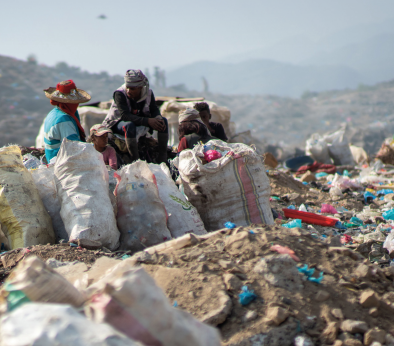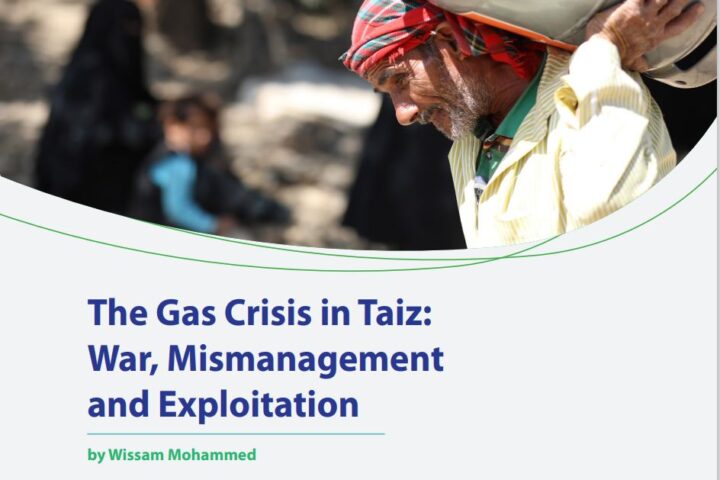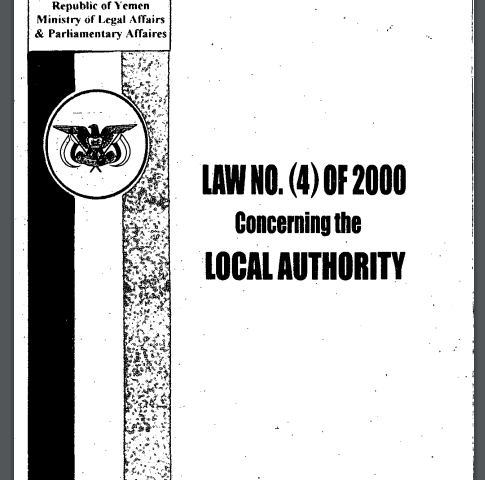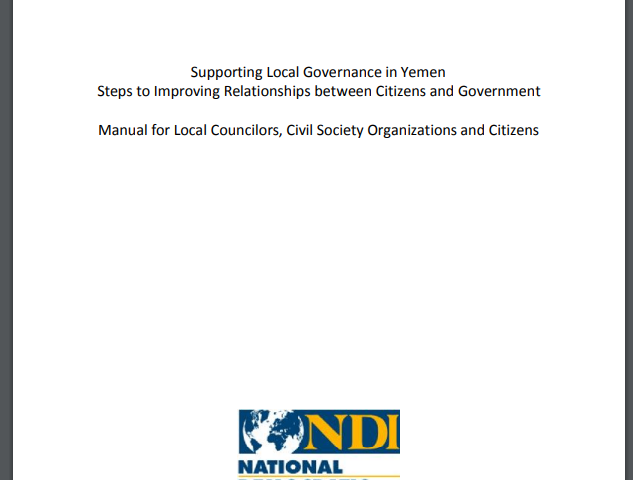The Governorate of Taiz is located in the central and southwestern part of Yemen, 256 kilometers south of the capital city Sana’a along the Red Sea coast overlooking the Bab Al-Mandab. The governorate is the most populous in Yemen and divided into 23 administrative districts, with the city of Taiz as the capital.
Taiz governorate information
Map of Taiz
Economy
Taiz has a more diversified economy than most Yemeni governorates. While agriculture and animal husbandry are key economic activities, a significant part of the workforce is engaged in fishing along the Red Sea coast. In addition, there are a number of industrial plants in the governorate, including Al-Barih Cement Factory and a range of light industries. There are also a number of stone, marble, sand, and salt quarries. Taiz is also home to traditional crafts, such as metalsmithing, jewelry making, stonemasonry, and textile and leather production.1Republic of Yemen, Presidency of the Council of Ministers, Governorate of Taiz, 2003-2008, prominent accomplishments for sustainable development, p. 25.
Taiz derived 93% of its total revenue from grants and central subsidies, while local revenues accounted for 7%. The most significant sources of local revenue were local shared revenues, especially from zakat, the sale of goods and services, fines and penalties, and taxes, and goods and services.2Republic of Yemen, Ministry of Finance, Budget Sector: estimated local authority budget for the 2014 fiscal year.
Taiz has been on the front lines of the conflict since 2015, with a blockade, regular shelling, and ongoing fighting taking a dramatic toll on a governorate that has long been Yemen’s economic heartland. The economy of Taiz was devastated by the war and the basis for local revenue generation has been eroded significantly.
According the 2014 Household Budget Survey, the poverty rate in Taiz governorate was 41%. After years of ongoing military confrontations, the poverty rate has increased sharply in the governorate.
Local governance
The local council in Taiz comprises 23 councilors and the governor. However, there are six vacant seats: three councilors have been appointed to other positions, two have passed away, and one has suspended their membership. More broadly, given the ongoing fighting in Taiz, most councilors have left the governorate, so that only four councilors remain inside the governorate. This has disrupted the work of the local council as well as the work of the administrative board. In theory, all tasks of the local authority are now being carried out by the governor, but the governor too is operating outside the governorate due to the volatile security situation and the closure of the administrative headquarters of the governorate. The executive offices are likewise unable to perform their mandates normally.3Interview with one of the members of the local council, Taiz. 20 March 2019.
Taiz has been the longest running and potentially the most deadly frontline of the armed conflict since 2015. Similar to the situation in Aden before August 2019, the situation in Taiz is increasingly complex and fragmented due to the diversity of armed actors who are all competing to control the governorate. Ansar Allah, forces affiliated with President Hadi and the Islah party, Salafi militias supported by the UAE, and Al-Qaeda all operate in the governorate, often at cross-purposes. There is also a plethora of other, smaller forces. This situation has destabilized the governorate’s security and prevented the local council or other parts of the local authority from carrying out their mandate.4Amal Eldeek and others, Pathways for Peace and Stability in Taiz, Yemen: an analysis of conflict Dynamics and Windows of Opportunity, Search for Common Ground, Yemen, 2018, p. 16-17.
Access to basic services
According to OCHA’s 2023 Humanitarian Needs Overview Yemen, there are more than 2 million people in need of assistance in Taiz (approximately 63% of the population), 62% of whom are in dire need.
Ta’iz has an IDP population of approximately 445.000 (status December 2022).5 https://data.humdata.org/dataset/yemen-humanitarian-needs-overview, 2023 People in Need in Yemen
In the health sector, the war, the disruption of salaries, and cuts to the operational budget of the governorate have been a source of major challenges to the provision of health services. Many healthcare centers have been closed. There are still a number of hospitals and health centers in operation, but the services they provide are insufficient and do not meet the needs of the population. Most rely on donor support. Due to the decline in health services and a scarcity of clean drinking water, there have been major epidemics of infectious diseases such as cholera threatening the lives of many in the governorate.6 Amal Eldeek and others, Pathways for Peace and Stability in Taiz, Yemen: an analysis of conflict Dynamics and Windows of Opportunity, Search for Common Ground, Yemen, 2018, p. 20-21.
Taiz has seen the highest number of schools damaged by the war, with at least 334 schools damaged.7OCHA, An Overview of the Humanitarian Needs in Yemen 2018. Teachers were being paid regularly, albeit only in the districts not under the control of the de facto government in Sana’a. Regular salary payments have allowed a measure of continuity and stability in education in some of Taiz’s districts, while the disruption has been more severe in others. According to some estimates, 468 out of 1,624 schools in the governorate (28%) have had to close, depriving nearly 250,000 students of education. Some schools have reopened in areas where salary payments for teachers have resumed.8Amal Eldeek and others, Pathways for Peace and Stability in Taiz, Yemen: an analysis of conflict Dynamics and Windows of Opportunity, Search for Common Ground, Yemen, 2018, p. 19-20.
As for drinking water, approximately 60% of households in Taiz had access to potable water in 2016/2017.9OCHA, An Overview of the Humanitarian Needs in Yemen 2018. Since 2015, water has been cut off in the city of Taiz and residents rely solely on water tankers for their water needs. The cost of water has doubled, and locals, especially children, have been exposed to waterborne diseases from contaminated tanker water, and from sewage spills and overflows. Moreover, disputes over water have increased by 20%.10Tawer Mujtama’ak Organization, Discussion of the Community Needs Assessment in the Water Supply and Sanitation Sector in the City of Taiz, 17 November 2018. http://www.iysoyemen.org/news/item/555-602 Date: 15 May 2019.
Demographics
| District | Size (km2) | Population (Female) | Population (Male) | Population (Total) |
|---|---|---|---|---|
| Mawiyah | 709 | 100,998 | 89,900 | 190,898 |
| Shara’b As Salam | 200 | 92,316 | 78,289 | 170,605 |
| Shara’b Ar Rawnah | 417 | 122,049 | 98,858 | 220,907 |
| Maqbanah | 1,168 | 150,046 | 122,050 | 272,096 |
| Al Mukha | 1,617 | 40,737 | 39,970 | 80,706 |
| Dhubab | 1,557 | 13,070 | 13,321 | 26,392 |
| Mawza’a | 665 | 10,923 | 10,248 | 21,170 |
| Jabal Habashy | 309 | 87,064 | 68,845 | 155,910 |
| Mashra’a Wa Hadnan | 15 | 4,024 | 3,438 | 7,462 |
| Sabir Al-Mawadim | 202 | 79,884 | 66,529 | 146,413 |
| Al-Misrakh | 91 | 74,525 | 63,435 | 137,960 |
| Dimnat Khadir | 460 | 97,635 | 84,059 | 181,694 |
| As Silw | 89 | 33,870 | 22,547 | 56,417 |
| Ash Shamayatayn | 918 | 143,532 | 104,198 | 247,731 |
| Al Wazi’iyah | 439 | 5,285 | 4,535 | 9,820 |
| Hayfan | 197 | 62,218 | 43,318 | 105,536 |
| Al-Mudhaffar | 161 | 87,455 | 93,011 | 180,466 |
| Al Qahirah | 161 | 62,281 | 64,896 | 127,177 |
| Salh | 161 | 41,492 | 42,587 | 84,080 |
| At Ta’iziyah | 161 | 149,619 | 141,565 | 291,183 |
| Al-Ma’afer | 209 | 89,801 | 68,089 | 157,890 |
| Al-Mawasit | 209 | 99,039 | 69,694 | 168,734 |
| Sama | 209 | 36,643 | 26,688 | 63,331 |
| TOTAL | 10,321 | 1,684,509 | 1,420,070 | 3,104,579 |
Figures are based on the 2021 Humanitarian Needs Overview Yemen, OCHA. Population figures include the number of IDPs and residents.






